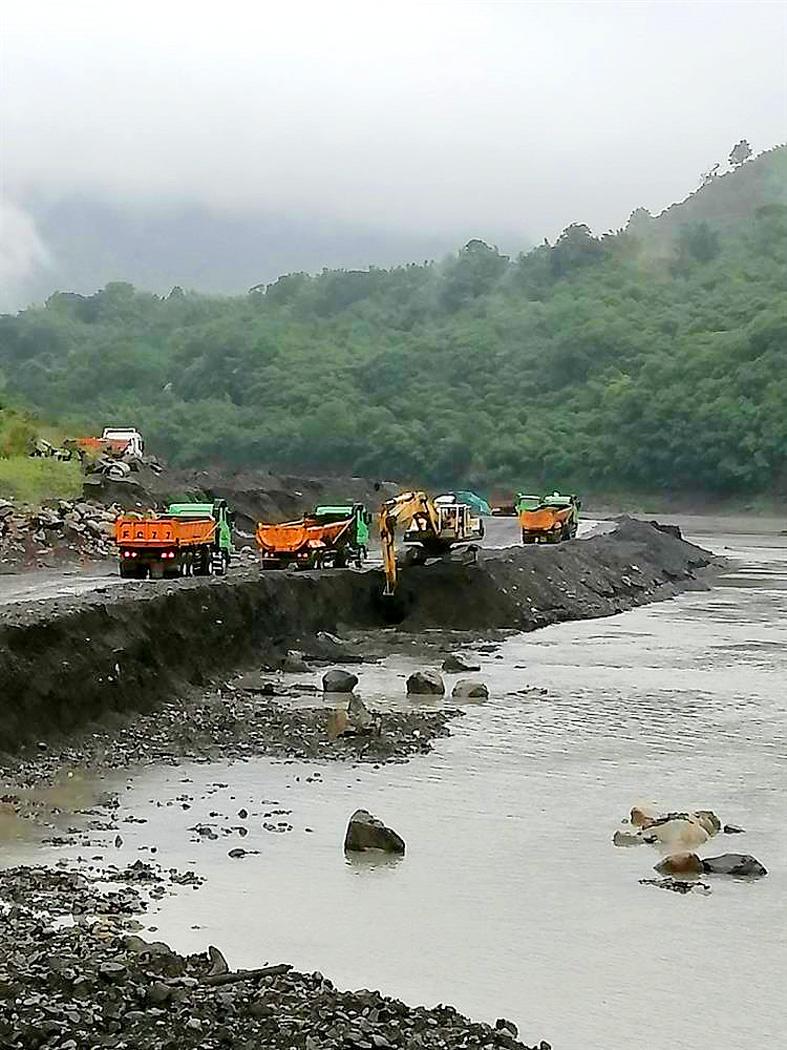Taiwan is facing the most severe water shortage in 56 years due to a lack of rainfall, but it is also the best time for reservoir dredging, as lower water levels expose silt and sand, the Water Resources Agency said in a statement on Friday.
As many reservoirs in Taiwan have over the years accumulated too much sediment and are losing storage capacity, the government has increased dredging efforts, the agency said in a statement.
Last year, dredging at the nation’s reservoirs had removed 14.4 million cubic meters of sediment, the most on record and about 2.6 times the annual average, the agency said.

Photo courtesy of Water Resources Agency
In the first three months of this year, the government had dredged 3.57 million cubic meters of sediment from reservoirs, an increase of 280,000 cubic meters from the 3.29 million cubic meters in the same period of last year, doubling the annual average of 1.79 million cubic meters over the past 10 years, the agency said.
“We will continue to dispatch more machinery and workers to increase excavation and maximize dredging,” the statement said.
The volume of dredging was in the past relatively small, as the government mainly used excavators and truck transportation for reservoir dredging.
However, the volume of dredging has continued to rise, due to better governance and management, including conservation of upstream reservoir catchment areas, excavation of bottom sediment in the reservoirs and the use of hydraulic systems for sand discharge, it said.
The government last year removed 3.34 million cubic meters of sediment from the Shihmen Reservoir (石門水庫) in Taoyuan and 3.82 million cubic meters from the Zengwen Reservoir (曾文水庫) in Chiayi County, which not only exceeded the annual accumulation of sediment, but also helped enhance the reservoirs’ capacity by 1.2 million cubic meters and 1.55 million cubic meters respectively, the agency said.
As the shortage persists, semiconductor companies, which use large amounts of water, are increasingly taking emergency measures to stabilize production.
As Taiwan Semiconductor Manufacturing Co (TSMC, 台積電) and United Microelectronics Co (UMC, 聯電) together account for more than 60 percent of the global foundry market, production disruption due to the water shortage would affect technology production worldwide.
TSMC has begun trucking water from reservoirs in northern Taiwan to its fabs in southern Taiwan. Local media last week reported that the chipmaker would purchase 100 water trucks, after the government further tightened water restrictions for some areas.
Minister of Economic Affairs Wang Mei-hua (王美花) on Friday said that she was not sure about the size of the water truck purchase, but believed that it is part of the company’s contingency plan to ensure uninterrupted production.
However, the water shortage would have limited effect on semiconductor companies, as the government has pledged to increase water supply to the firms, she said.
UMC said it has also purchased water trucks, while other semiconductor firms might follow suit, local media reported.
If the shortage continues through the second half of this month, water levels at reservoirs would fall further, and trucking water to factories would become more common, the reports said.

NOT JUSTIFIED: The bank’s governor said there would only be a rate cut if inflation falls below 1.5% and economic conditions deteriorate, which have not been detected The central bank yesterday kept its key interest rates unchanged for a fifth consecutive quarter, aligning with market expectations, while slightly lowering its inflation outlook amid signs of cooling price pressures. The move came after the US Federal Reserve held rates steady overnight, despite pressure from US President Donald Trump to cut borrowing costs. Central bank board members unanimously voted to maintain the discount rate at 2 percent, the secured loan rate at 2.375 percent and the overnight lending rate at 4.25 percent. “We consider the policy decision appropriate, although it suggests tightening leaning after factoring in slackening inflation and stable GDP growth,”

DIVIDED VIEWS: Although the Fed agreed on holding rates steady, some officials see no rate cuts for this year, while 10 policymakers foresee two or more cuts There are a lot of unknowns about the outlook for the economy and interest rates, but US Federal Reserve Chair Jerome Powell signaled at least one thing seems certain: Higher prices are coming. Fed policymakers voted unanimously to hold interest rates steady at a range of 4.25 percent to 4.50 percent for a fourth straight meeting on Wednesday, as they await clarity on whether tariffs would leave a one-time or more lasting mark on inflation. Powell said it is still unclear how much of the bill would fall on the shoulders of consumers, but he expects to learn more about tariffs

Greek tourism student Katerina quit within a month of starting work at a five-star hotel in Halkidiki, one of the country’s top destinations, because she said conditions were so dire. Beyond the bad pay, the 22-year-old said that her working and living conditions were “miserable and unacceptable.” Millions holiday in Greece every year, but its vital tourism industry is finding it harder and harder to recruit Greeks to look after them. “I was asked to work in any department of the hotel where there was a need, from service to cleaning,” said Katerina, a tourism and marketing student, who would

i Gasoline and diesel prices at fuel stations are this week to rise NT$0.1 per liter, as tensions in the Middle East pushed crude oil prices higher last week, CPC Corp, Taiwan (台灣中油) and Formosa Petrochemical Corp (台塑石化) said yesterday. International crude oil prices last week rose for the third consecutive week due to an escalating conflict between Israel and Iran, as the market is concerned that the situation in the Middle East might affect crude oil supply, CPC and Formosa said in separate statements. Front-month Brent crude oil futures — the international oil benchmark — rose 3.75 percent to settle at US$77.01